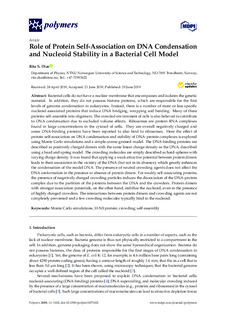| dc.contributor.author | Dias, Rita | |
| dc.date.accessioned | 2020-01-16T06:53:21Z | |
| dc.date.available | 2020-01-16T06:53:21Z | |
| dc.date.created | 2019-11-15T20:47:52Z | |
| dc.date.issued | 2019 | |
| dc.identifier.citation | Polymers. 2019, 11 (7), 1-18. | nb_NO |
| dc.identifier.issn | 2073-4360 | |
| dc.identifier.uri | http://hdl.handle.net/11250/2636524 | |
| dc.description.abstract | Bacterial cells do not have a nuclear membrane that encompasses and isolates the genetic material. In addition, they do not possess histone proteins, which are responsible for the first levels of genome condensation in eukaryotes. Instead, there is a number of more or less specific nucleoid-associated proteins that induce DNA bridging, wrapping and bending. Many of these proteins self-assemble into oligomers. The crowded environment of cells is also believed to contribute to DNA condensation due to excluded volume effects. Ribosomes are protein-RNA complexes found in large concentrations in the cytosol of cells. They are overall negatively charged and some DNA-binding proteins have been reported to also bind to ribosomes. Here the effect of protein self-association on DNA condensation and stability of DNA-protein complexes is explored using Monte Carlo simulations and a simple coarse-grained model. The DNA-binding proteins are described as positively charged dimers with the same linear charge density as the DNA, described using a bead and spring model. The crowding molecules are simply described as hard-spheres with varying charge density. It was found that applying a weak attractive potential between protein dimers leads to their association in the vicinity of the DNA (but not in its absence), which greatly enhances the condensation of the model DNA. The presence of neutral crowding agents does not affect the DNA conformation in the presence or absence of protein dimers. For weakly self-associating proteins, the presence of negatively charged crowding particles induces the dissociation of the DNA-protein complex due to the partition of the proteins between the DNA and the crowders. Protein dimers with stronger association potentials, on the other hand, stabilize the nucleoid, even in the presence of highly charged crowders. The interactions between protein dimers and crowding agents are not completely prevented and a few crowding molecules typically bind to the nucleoid. | nb_NO |
| dc.language.iso | eng | nb_NO |
| dc.publisher | MDPI | nb_NO |
| dc.rights | Navngivelse 4.0 Internasjonal | * |
| dc.rights.uri | http://creativecommons.org/licenses/by/4.0/deed.no | * |
| dc.title | Role of protein self-association on DNA condensation and nucleoid stability in a bacterial cell model | nb_NO |
| dc.type | Journal article | nb_NO |
| dc.type | Peer reviewed | nb_NO |
| dc.description.version | publishedVersion | nb_NO |
| dc.source.pagenumber | 1-18 | nb_NO |
| dc.source.volume | 11 | nb_NO |
| dc.source.journal | Polymers | nb_NO |
| dc.source.issue | 7 | nb_NO |
| dc.identifier.doi | 10.3390/polym11071102 | |
| dc.identifier.cristin | 1748234 | |
| dc.description.localcode | © 2019 by the authors. Licensee MDPI, Basel, Switzerland. This article is an open access article distributed under the terms and conditions of the Creative Commons Attribution (CC BY) license (http://creativecommons.org/licenses/by/4.0/). | nb_NO |
| cristin.unitcode | 194,66,20,0 | |
| cristin.unitname | Institutt for fysikk | |
| cristin.ispublished | true | |
| cristin.fulltext | original | |
| cristin.qualitycode | 1 | |

